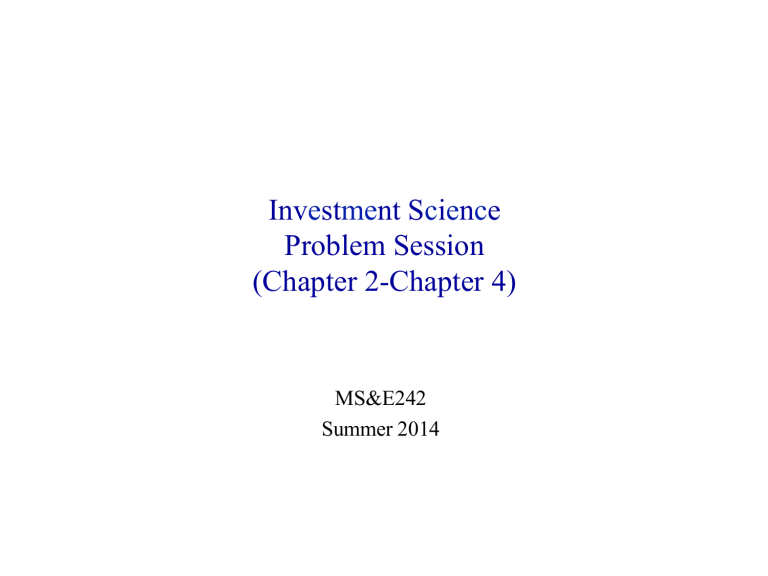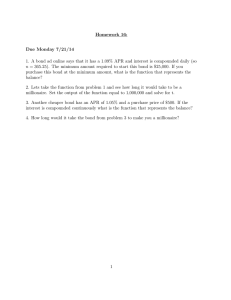
Investment Science Problem Session (Chapter 2-Chapter 4) MS&E242 Summer 2014 Chapter 4: 1. Spot rates and forward rates 2 Chapter 4: 1. Spot rates and forward rates Problem 1: Chapter 4, Exercise 2 Given the (yearly) spot rate curve s=(5.0, 5.3, 5.6, 5.8, 6.0, 6.1), find the spot rate curve for next year. 3 Chapter 4: 2. Discount factor and running PV 4 Running present value 5 Running present value 6 Present value updating 7 Example: present value updating Year k 0 1 2 3 4 5 6 7 Cash flow 20 25 30 35 40 30 20 10 Short rate 0.060 0.069 0.075 0.080 0.084 0.086 0.090 Discount factor PV(k) 0.943 0.935 0.930 0.926 0.922 0.921 0.917 169.06 158.01 142.19 120.61 92.46 56.87 29.17 10.00 8 Present value updating (cont.) 9 Example: floating rate bond 10 Chapter 4: 2. Discount factor and running PV Problem 2: Chapter 4, Exercise 11 A (yearly) cash flow stream is x=(-40, 10, 10, 10, 10, 10, 10). The spot rate are those of Exercise 2. (a) Find the current discount factor d0,k and use them to determine the (net) present value of the stream. (b) Find the series of expectations dynamics short-rate discount factors, and use the running present value method to evaluate them. 11 Chapter 4: 2. Discount factor and running PV Problem 2: Chapter 4, Exercise 11 12 Duration in the context of the term structure 12% 10% Rate 8% 6% 4% 2% 0% 0 2 4 6 8 10 12 14 16 18 20 Years 13 Fisher-Weil duration 14 Fisher-Weil duration (cont.) 15 Fisher-Weil formulas 16 Chapter 4: 3. Construction of zero coupon bonds Problem 3: Chapter 4, Exercise 7 17 Chapter 4: 3. Construction of zero coupon bonds Problem 3: Chapter 4, Exercise 7 18 Chapter 3: 1. Amortization 19 Problem 4: Chapter 3, Exercise 5 (Mortgage restructuring) An investor purchased a small apartment building for $250,000. She made a down payment of $50,000 and financed the balance with a 30-year, fixed rate mortgage at 12% annual interest rate, compounded monthly. For exactly 20 years she has equal-sized monthly payments as required by the terms of the loan. Now she has the opportunity to restructure the mortgage by refinancing the balance. She could borrow the current balance, payoff the original loan, and assume a new loan for the balance. (No points for any other charges are involved in the transaction.) The new loan is a 20year, fixed-rate loan at 9%, compounded monthly, to be paid in equal monthly installments. Suppose she has a risk-free savings account that pays 5%, compounded monthly. Should she restructuring the mortgage? 20 Problem 4: Chapter 3, Exercise 5 21 Chapter 3: 2. Bond Formulas • Yield • Duration 22 Problem 5: Chapter 3, Exercise 7 The Z corporation issues a 10%, 20-year bond at a time when yields are 10%. The bond has a call provision that allows the corporation to force a bond holder to redeem his or her bond at face value plus 5%. After 5 years the corporation finds that exercise of this call provision is advantageous. What can you deduce about the yield at that time? (Assume one coupon payment per year) 23 Problem 6: 2013 Midterm, problem 5 Duration (10 points). Rank the following securities according to their interest rate sensitivity in declining order: 1) A 30-year zero coupon bond at 6% 2) A 30-year fixed-rate mortgage with an interest rate of 6% 3) A 30-year bond with a coupon rate of 6% 4) A 30-year bond with a coupon rate of 3% Solution: 1) - 4) - 3) - 2) 24 Chapter 3: 3. Immunization 25 Duration of a portfolio 26 Immunization 27 Example: Immunization 28 Example: Immunization (cont.) 29 Shortcomings of immunization 30 Problem 7: Chapter 3, Exercise 16 Consider the four bonds having annual payments as shown in Table 3.9. They are traded to produce a 15% yield. (a) Determine the price of each bond. (b) Determine the duration of each bond (not the modified duration). (c) Which bond is most sensitive to a change in yield? Solution: (a)PA=885.84; PB=771.68; PC=657.52; PD=869.57 (b)DA=2.72; DB=2.84; DC=3.00; DD=1.00 (c)C is most sensitive to a change in yield. 31 Problem 7: Chapter 3, Exercise 16 (cont.) (d) Suppose you owe $2,000 at the end of 2 years. Concern about interest rate risk suggests that a portfolio consisting of the bonds and the obligation should be immunized. If VA, VB, VC, and VD are the total values of bonds purchased of types A, B, C and D, respectively, what are the necessary constraints to implement the immunization? [Hint: There are two equations. (Do not solve)] 32 Problem 7: Chapter 3, Exercise 16 (cont.) (e) In order to immunize the portfolio, you decide to use bond C and one other bond. Which other bond should you choose? Find the amounts (in total value) of each of these to purchase. 33 Chapter 2: 1. Compounding and effective interest rate r: annual interest rate, compounded with m periods in one year reff : effective yearly interest rate without compounding Problem 8: Chapter 2, Exercise 3 Find the corresponding effective rates for (a)3% compounded monthly (b)18% compounded monthly (c)18% compounded quarterly (d)18% compounded continuously (not included) 34 Chapter 2: 1. Compounding and effective interest rate r: annual interest rate, compounded with m periods in one year reff : effective yearly interest rate without compounding Problem 8: Chapter 2, Exercise 3 Find the corresponding effective rates for (a)3% compounded monthly: r=3%, m=12!reff=3.04% (b)18% compounded monthly: r=18%, m=12!reff=19.56% (c)18% compounded quarterly: r=18%, m=4!reff=19.25% (d)18% compounded continuously: r=18%!reff=19.72% 35 Chapter 2: 2. Project Evaluation: NPV vs. IRR Problem 9: Chapter 2, Exercise 8 A young couple has made a nonrefundable deposit of the first month’s rent (equal to $1,000) on a 6-month apartment lease. The next day they find a different apartment that they like just as well, but its monthly rent is only $900. They plan to be in the apartment only 6 months. Should they switch to the new apartment? What if they plan to stay 1 year? Assume an interest rate of 12% 36 Chapter 2: 2. Project Evaluation: NPV vs. IRR Solution: 1. Identify the cash flows of each option 37 Chapter 2: 2. Project Evaluation: NPV vs. IRR 2. Find the NPV for each option For 6 months: NPV1>NPV2 They should not switch For 1 year: NPV1<NPV2 They should switch 38 Chapter 2: 2. Project Evaluation: NPV vs. IRR Summary: 1. Identify the cash flows of each project • Positive or negative? • Compounding methods? 2. Evaluation criteria: • NPV>0 for the project to be feasible, the larger the better • IRR> discount rate for the project to be feasible, the larger the better 39 Chapter 2: 2. Project Evaluation: NPV vs. IRR Summary: 3. NPV vs. IRR • Disadvantages of NPV • Complex and require assumptions of each stage • Disadvantages of IRR • Not account for the changing discount rate over time • Cash flows may have multiple IRR • The external discount rate of the project is unknown • In most cases, the NPV method is superior. 40 Problem 10: Chapter 2, Exercise 11 You are considering the purchase of of a nice home. It is every way perfect for you and in excellent condition, except for the roof. The roof has only 5 years of life remaining. A new roof would last 20 years, but would cost $20,000. The house is expected to last forever. Assuming that costs will remain constant and that the interest rate is 5%, what value would you assign to the existing roof? Solution:) 1) Change)roof)now,)then)every)20)years:) ! 1 !"! = $20,000× = $32,097) (1.05)!"! !!! 2) Use)the)existing)roof)for)5)years)and)then)change)to)a)new)one,)then)every)20) years:)) !"! !"! = = $25,149) (1.05)! The)value)of)the)existing)roof)is)the)difference)of)!"! )and)!"! :)) !"! − !"! = $6,948) 41




